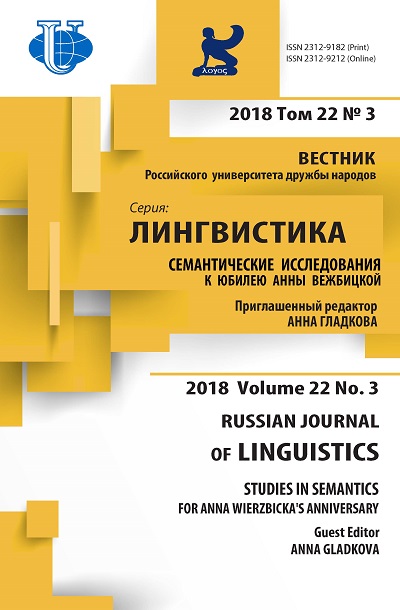The Semantics of Logical Connectors: therefore, moreover and in fact
- Authors: Wong J.O.1
-
Affiliations:
- National University of Singapore Centre for English Language Communication
- Issue: Vol 22, No 3 (2018): Studies in semantics: for Anna Wierzbicka’s anniversary
- Pages: 581-604
- Section: STUDIES IN SEMANTICS: For Anna Wierzbicka’s anniversary
- URL: https://journals.rudn.ru/linguistics/article/view/19348
- DOI: https://doi.org/10.22363/2312-9182-2018-22-3-581-604
- ID: 19348
Cite item
Full Text
Abstract
About the authors
Jock Onn Wong
National University of Singapore Centre for English Language Communication
Email: jockonn@gmail.com
lecturer at the Centre for English Language Communication, National University of Singapore, where he teaches semantics, pragmatics, and academic writing. His research interests include semantics, pragmatics, language and culture, English Language teaching, Singapore English and Anglo English. He has written a number of papers on Singapore English, Anglo English and English language teaching. His book, ‘The Culture of Singapore English’ (2014, Cambridge University Press), discusses how Singapore English reflects Singaporean meanings, values and other world views. He believes that when one learns a language, one should go beyond grammar and understand the meanings and culture it is associated with. 10 Architecture Drive, Singapore 117511
References
- Allan, K. (1986). Linguistic Meaning, Volume 1. London: Routledge and Kegan Paul.
- Carter, R. A. (1987). Is there a Core Vocabulary? Some Implications for Language Teaching. Applied Linguistics, 8(2), 64-72. doi:https://doi.org/10.1093/applin/8.2.178
- Celce-Murcia, M., & Larsen-Freeman, D. (1999). The Grammar Book: An ESL/EFL Teacher's Course (Second edition). Boston: Heinle & Heinle.
- Gladkova, A., & Romero-Trillo, J. (2014). Ain’t it beautiful? The conceptualization of beauty from an ethnopragmatic perspective. Journal of Pragmatics, 60, 140-159.
- Goddard, C. (ed.). (2006). Ethnopragmatics: A Fresh Approach to Discourse in Culture. Berlin: Mouton de Gruyter.
- Goddard, C. (ed.). (2008). Cross-Cultural Semantics. Amsterdam: John Benjamins.
- Goddard, C. (2011). Semantic Analysis: A Practical Introduction (Second ed.). Oxford: Oxford University Press.
- Goddard, C., & Wierzbicka, A. (eds.). (1994). Semantic and Lexical Universals: Theory and Empirical Findings. Amsterdam: John Benjamins.
- Goddard, C., & Wierzbicka, A. (eds.). (2002). Meaning and Universal Grammar: Theory and Empirical Findings (Vol. 1). Amsterdam: John Benjamins.
- Goddard, C., & Wierzbicka, A. (2007). Semantic primes and cultural scripts in language learning and intercultural commnication. In S. Farzad, & G. B. Palmer (Eds.), Applied Cultural Linguistics: Implications for Second Langauge Learning and Intercultural Communication (pp. 105-124). Amsterdam: John Benjamins.
- Goddard, C., & Wierzbicka, A. (2018). Minimal English and how it can add to Global English. In C. Goddard (Ed.), Minimal English for a Global World: Improved Communication Using Fewer words (pp. 5-27). Cham: Palgrave Macmillan.
- Halliday, M. A., & Matthiessen, C. M. (2014). Halliday's Introduction to Functional Grammar (Fourth edition). Abingdon: Routledge.
- Hallliday, M. A., & Hassan, R. (1976). Cohesion in English. New York: Longman.
- Ho, S. T., & Khor, N. H. (2010). Panpac Additional Mathematics. Singapore: Marshall Cavendish Education.
- Peeters, B. (ed.). (2006). Semantic Primes and Universal Grammar: Empirical Evidence from the Romance Languages. Amsterdam: John Benjamins.
- Wierzbicka, A. (1972). Semantic Primitives. Frankfurt: Athenäum.
- Wierzbicka, A. (1986). Introduction (Special issue on 'Particles'). Journal of Pragmatics, 10(5), 519-534.
- Wierzbicka, A. (1988). The Semantics of Grammar. Amsterdam: John Benjamins.
- Wierzbicka, A. (1991). Cross-Cultural Pragmatics: The Semantics of Human Interaction. Berlin: Mouton de Gruyter.
- Wierzbicka, A. (1992). Semantics, Culture and Cognition: Universal Human Concepts in CultureSpecific Configurations. New York: Oxford University Press.
- Wierzbicka, A. (1996). Semantics: Primes and Universals. Oxford: Oxford University Press. Wierzbicka, A. (1997). Understanding Cultures through Their Key Words: English, Russian, Polish, German and Japanese. New York: Oxford University Press.
- Wierzbicka, A. (1999). Emotions across Languages and Cultures: Diversity and Universals. Cambridge: Cambridge University Press.
- Wierzbicka, A. (2001). What did Jesus Mean? Explaining the Sermon on the Mount and the Parables in Simple and Universal Human Concepts. Oxford: Oxford University Press.
- Wierzbicka, A. (2004). Jewish cultural scripts and the interpretation of the Bible. Journal of Pragmatics, 36(3), 575-599.
- Wierzbicka, A. (2006). English: Meaning and Culture. New York: Oxford University Press. Wierzbicka, A. (2013). Imprisoned in English: The Hazards of English as a Default Language. New York: Oxford University Press.
- Wierzbicka, A. (2018). Emotions of Jesus. Russian Journal of Linguistics, 22(1), 38-53. Retrieved from http://journals.rudn.ru/linguistics/article/view/17846/15441
- Wong, J. O. (2014). The Culture of Singapore English. Cambridge: Cambridge University Press. Ye, Z. (Ed.). (2017). The Semantics of Nouns: A Cross-Linguistic and Cross-Domain Perspective. Oxford: Oxford University Press.
- Yoon, K.-J. (2005). Constructing a Korean Natural Semantic Metalanguage. Seoul: Hankook.
Supplementary files















